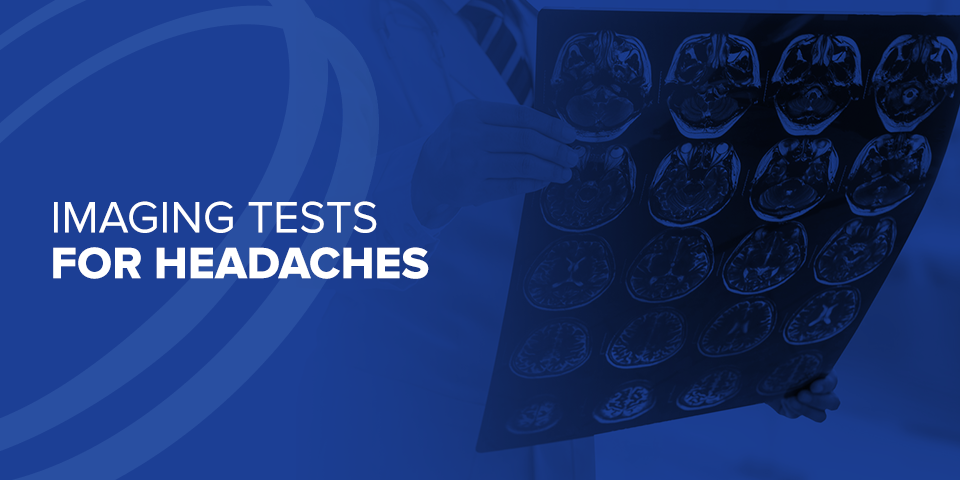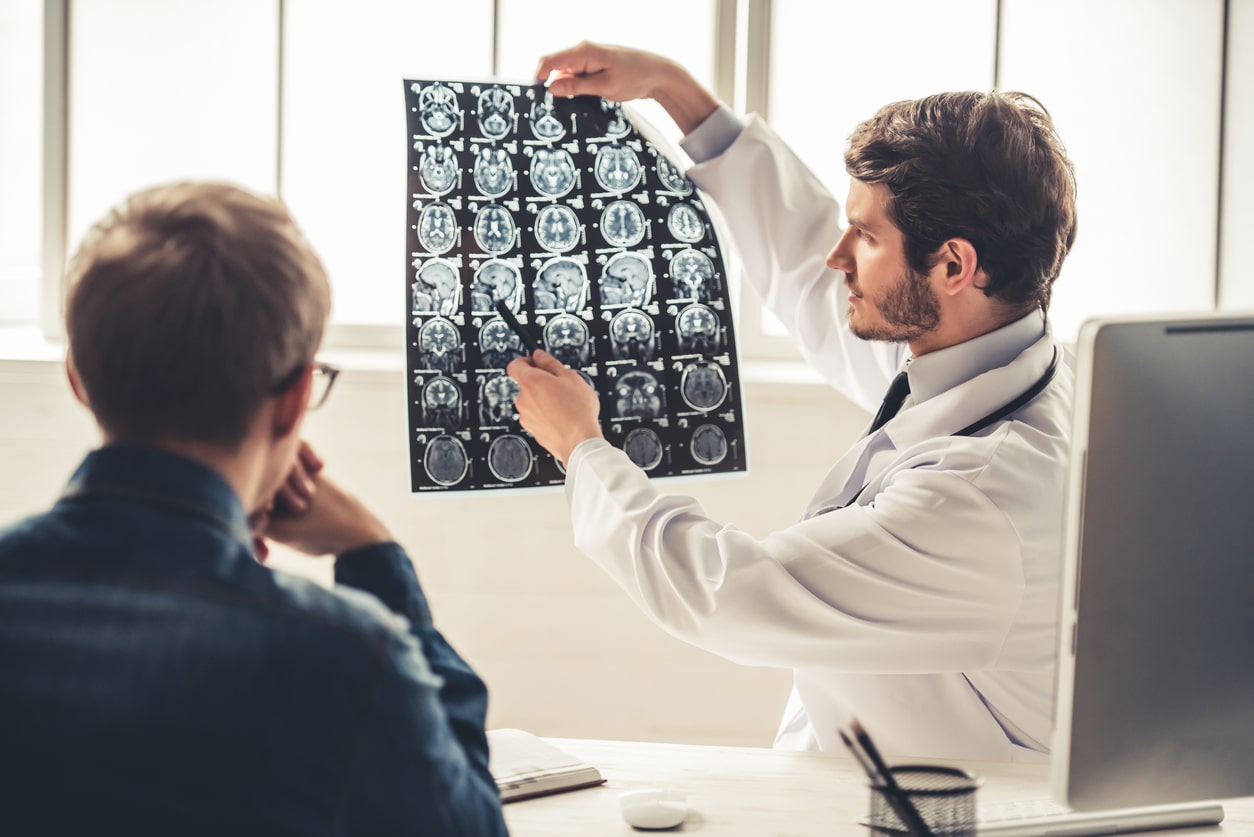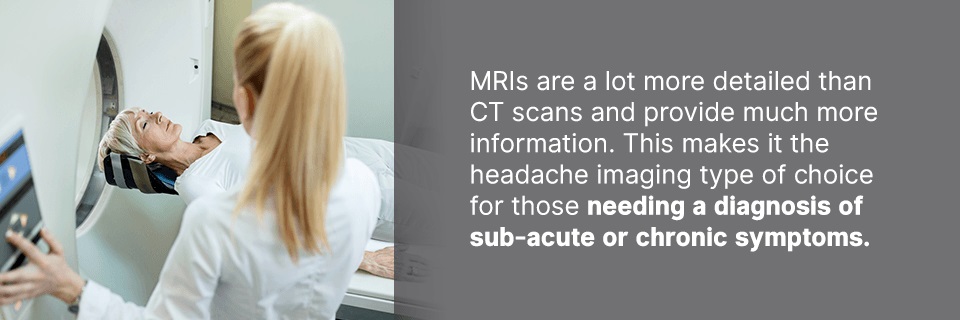Imaging Tests for Headaches

Headaches are a common phenomenon, with half to three-quarters of adults having had one in the past year. Among those reporting headaches, 30 percent or more report having migraines. While most people with headaches only experience them from time to time, up to four percent of the world’s adult population experience headaches on 15 days or more each month. When chronic headaches begin to interfere with your life, it may be time to seek an imaging test to rule out certain conditions and help your doctor make a diagnosis.
Common Headache Disorders
There are a few different types of headache disorders that could explain your symptoms. These are the diagnoses your doctor will investigate first, before ordering imaging tests for headaches:
- Migraine: This primary headache disorder is most common in women. It causes the brain to release inflammatory substances near nerves and blood vessels that cause moderate-to-severe pulsating pain for hours or even days.
- Tension-type headache (TTH): This is the most common headache disorder — it is usually not debilitating and does not require intervention. When chronic, TTH can be highly disruptive and require treatment as recommended by a physician.
- Cluster headache (CH): The primary headache disorder CH affects fewer than one in 1000 adults and is more common in men. It causes multiple severe headaches per day and may be episodic or chronic.
- Medication-overuse headache (MOH): When someone excessively uses medication to treat headaches, it can backfire and make headaches worse. MOH is the most common secondary headache disorder.
While these disorders are the most common to experience, there are cases where headaches are caused by injuries or conditions that need further examination.
Types of Imaging Tests for Headaches
If your doctor is unable to accurately diagnose your chronic headaches or migraines, they might order headache imaging tests. There are three varieties of headache imaging scans you might undergo in the diagnostic process:
1. X-Ray for Headaches
X-rays are the least likely test for a doctor to order. They don’t pick up soft tissue — instead, they show only the condition of the skull. An x-ray for headaches may be useful if your doctor suspects the headaches are caused by a poorly healed break or fracture from an accident, for example. Alternatively, a sinus x-ray may be able to indicate whether the headaches are resulting from issues in the sinus cavity.
Although x-rays are rarely used on their own, they form a critical component of CT scans for headache diagnosis.
2. CT Scan for Headaches
A computerized tomography (CT) scan, also known as a CAT scan, may help diagnose headaches by providing images of the brain. A CT scan works similarly to traditional x-ray exams. Parts of the body absorb different amounts of x-rays, with the difference allowing physicians to identify separate body parts. CT scans use multiple x-ray beams and detectors, which rotate around you in the test chamber, producing a huge amount of data to provide a 2D image of your body. These images can rule out:
- Brain tumors
- Abscess or infection of the brain
- Fluid buildup in the brain
- Sinus blockages
- Injury or trauma
- A brain aneurysm
- Bleeding in the brain
3. MRI for Headaches
Magnetic resonance imaging (MRI) scans do not use x-rays to create brain images. Instead, an MRI scan uses radio waves and magnets to produce the results. MRIs are a lot more detailed than CT scans and provide much more information. This makes it the headache imaging type of choice for those needing a diagnosis of sub-acute or chronic symptoms. However, the detail comes at the expense of time, with MRI scans taking up to an hour or sometimes even 90 minutes to capture all the necessary images.
MRIs often use a contrast agent to enhance the definition of the end images. This involves receiving an injection in the arm, which may make you feel flushed. Before the MRI exam, you can eat normally and continue taking your medications. Leave all jewelry at home and be prepared to change into a hospital gown, as these items are prohibited in the MRI scanner room:
- Watches
- Credit cards
- Hearing aids
- Pins and hairpins
- Metal zippers
- Removable dental work
- Pens
- Eyeglasses
- Body piercings
- Mobile phones
If you have any electronic or medical devices in your body, it’s critical to inform your technologist. Certain devices can interfere with the scan or pose the risk of harm to you. CT scans are recommended for those with medical implants.
A brain MRI for headaches is very loud, so most imaging centers will provide you with music to listen to through headphones to minimize auditory discomfort during the scan.
When to Seek an Imaging Test for Headaches
How do you know when your headache symptoms are severe enough to warrant imaging tests? Doctors do not usually order headache imaging unless you meet one or more of these criteria:
- Suddenly experiencing a particularly intense headache.
- Sudden changes in the patterns of your headaches.
- Having new headaches when you’re over the age of 50.
- Having headaches related to your position, such as a headache being triggered by sitting or standing and feeling better when you lie flat.
- Experiencing seizures in combination with headache.
- Hearing a pulsating or “whooshing” sound during headaches.
- Having headaches after a recent head injury.
- Experiencing altered consciousness, impaired speech, weakness, numbness, confusion or problems with physical coordination.
- Headaches in combination with established medical problems such as HIV or cancer.
- Headaches triggered by exercise, going to the bathroom, coughing or sneezing.
- Headaches that don’t respond to recommended medications.
If you are experiencing what seems like undue worry or fear about the quantity and intensity of your headaches, that’s a good reason to seek headache imaging as well. Your doctor should take your headache-related stress or anxiety into account when deciding whether to order imaging tests for headaches.
Trust Health Images
If your doctor orders a CT or MRI scan for headache diagnosis, you’ll need to select an imaging company you can trust. For affordable pricing and convenience in Denver/Boulder, Colorado, come to Health Images. Our dedication to compassion and expertise results in an optimal patient experience for everyone who walks through our doors.
Health Images offers a variety of imaging services, including imaging tests for headaches, and we are proud to produce accurate images. Our electronic medical record system ensures your physician gets your results fast, so they can find the source of your pain efficiently. To learn more about our services and schedule your scan, find your nearest Health Images location online.
Sources:
- https://www.who.int/news-room/fact-sheets/detail/headache-disorders
- https://www.healthimages.com/services/x-ray/
- https://www.healthimages.com/services/ct-scans/
- https://www.radiologyinfo.org/en/info.cfm?pg=headct
- https://www.healthimages.com/services/mri-scans/
- https://www.aan.com/siteassets/home-page/policy-and-guidelines/quality/quality-improvement/patient-handouts/14headacheimagingsdmtool_pg.pdf
- https://www.healthimages.com/locations/





